What to Know
- Smash rooms, also known as "rage rooms," are believed to have originated in Japan during the early 2000s
- The rooms are stocked with breakable electronics, furniture and glassware donated by local businesses, and customers are also encouraged to bring their own items to smash
- Customers get 20 to 30 minutes to do as much damage as they can with a selection of "weapons" including crowbars, sledgehammers and baseball bats
Miguel Moises always knew he wanted to start a business.
But when he began looking for locations and applying for permits, he had something entirely different in mind. The year was 2020, and Miguel had his heart set on opening a bar: the kind of business where glassware is generally only broken by accident.
"The permits were not going through because of COVID," he said. "I was on vacation in Miami, and I was stressed out."
Get a weekly recap of the latest San Francisco Bay Area housing news. Sign up for NBC Bay Area’s Housing Deconstructed newsletter.
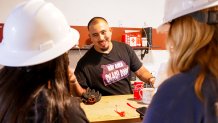
Miguel said he'd heard about rage rooms — a Japanese phenomenon that had slowly begun making its way to America. With a quick Google search, he found one in Miami.
"I went to a rage room in Miami, tried it, loved it, came back home, I was still stressed out," he said. "I said the Bay Area needs something like this — and the Bay Area Smash Room was born."
Miguel now operates two smash rooms: one in Fairfield and one in San Francisco. Other nearby rage rooms include Break Stuff in San Jose and Smash Sacramento.
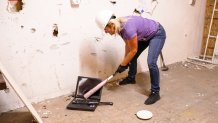
At Bay Area Smash Room, prices start at $65 for a quick 20-minute smash, and range all the way up to $360 for a full hour of smashing with up to 10 people in a room well-stocked with plates and electronics. And if an hour of smashing stuff with an army of friends sounds a little exhausting, Miguel says you're not wrong.
Local
"Every time, they leave smiles and tired," he said. "Sweating, because it's a workout in there!"
Every smashing session starts with a safety briefing.
"Please do not hit the walls, the door, or each other with the weapons today," Miguel says, grinning ear to ear, as he hands out hard hats, safety glasses and gloves.

By "weapons," he's referring to the implements of demolition: baseball bats, crowbars and sledgehammers, just to name a few. They hang on a wall outside the establishment's three smash rooms for easy access on the way in.
Neatly stacked off to the side, Miguel pointed out the "breakables" — most of them donated by local businesses.
"We have some smart boards, some printers, some furniture," he said. "They're breakables, meant to be broken, they will be broken by the end of the day."
The rooms themselves are made to take a beating, with easily-replaced boards covering the walls and chicken wire protecting the light fixtures.
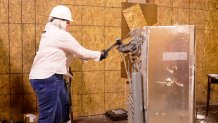
"We do have a window right here," Miguel said, pointing out the spot where guests in the lobby can peek in at the smashing. "It is normally open, but someone just broke it yesterday, so we had to cover it up."
Colorful scribbling covers the walls of the lobby. Miguel encourages customers to sign the walls when they're done smashing, and the results are equal parts profound and profane.
"A lot of people say they hate their exes," Miguel said, pointing out some choice words on the wall nearest the front desk.

Through all the scribbling, and all his conversations with customers, Miguel said he learned something about the business he's in.
"Honestly, that it's not all about fun, you know, some people do need this," he said. "We support some people that have just gone through death, and they need a healthy outlet."
Indeed, among the customers who came in a steady stream one afternoon, many said there's something decidedly therapeutic about smashing big objects with a 40-pound sledgehammer and swinging at flying plates with a baseball bat.
"Just the therapy of being able to smash stuff, break it, and not have to clean up the mess," said one woman who brought her whole family to smash things. To Miguel, she added: "It's a huge mess in there — sorry!"
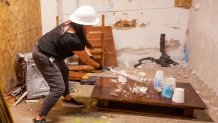
To be clear, those who actually practice psychotherapy don't recommend smashing things as a way to treat stress. But they've certainly given a lot of thought to why it feels good.
"People don't like feeling vulnerable; stress makes us feel vulnerable," said David Spiegel, a psychiatrist at Stanford. "And I think what happens when people want to break things is they want to be the breaker, not the broken."
Spiegel runs Stanford's Center on Stress and Health, where he studies the use of hypnosis to help patients reduce stress and get better sleep. He even has an app, Reveri, to help you hypnotize yourself in the comfort of your own home. It's the very antithesis of smashing things when you're stressed — an urge he says is likely rooted deep in our genetic code.
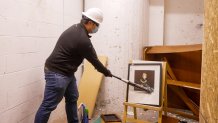
"As a species, we evolved to deal with physical stressors: can I get away from that saber-toothed tiger or that neighboring tribe that doesn't like me," he said. "Most of the stressors that we feel (nowadays) are psychological stressors: things I have to do, things I need to worry about. … So you're ready to fight or flee when, in fact, that's not what you need to do."
But faced with the psychological stressors of modern life, the ongoing pandemic, and the holidays on top of it all, the market for smashing things only seems to be growing — even though there's no medical evidence it actually reduces stress. And just like the bar he'd originally planned to open, Miguel's smash rooms now have a growing group of regulars.
"I have a group of grandmas, they come once a month, they smash all glass," Miguel said. "They bring their own glass too, and have the time of their lives."



